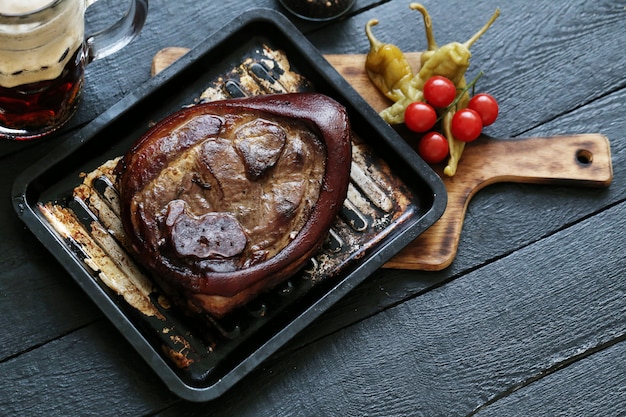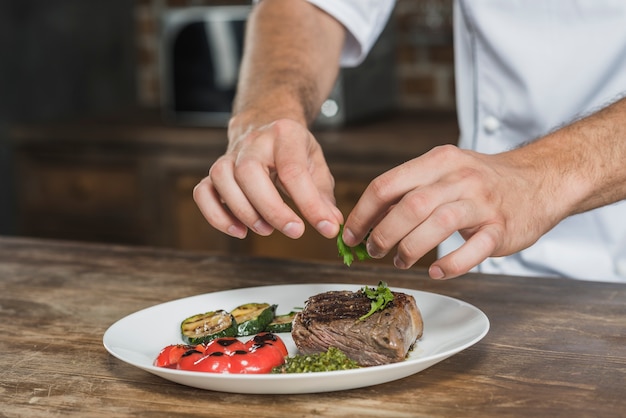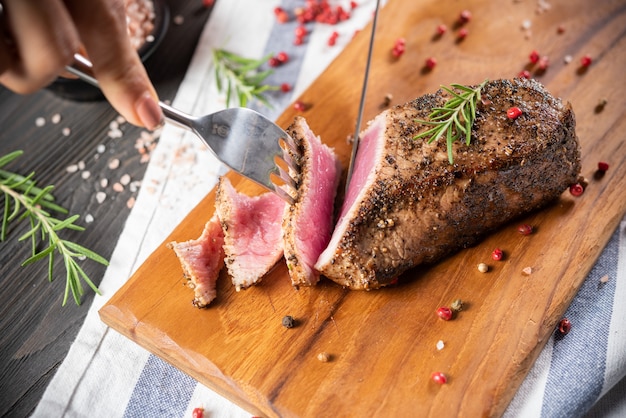(Part 1) The Art of the Steak

I've always been a fan of steak. The aroma of sizzling meat, the satisfying crunch when you bite into it, the richness of the flavour – it's a sensory experience that can't be beat. But there's a right way and a wrong way to cook steak. And, let's face it, we've all been there – the overcooked, tough, dry nightmare of a steak. It's a travesty. So, let's get this right. We're aiming for medium rare, that delicious balance between a slightly pink centre and a gorgeous, crispy exterior.
It's that perfect "give" when you press your fork into the steak, that beautiful pink hue peeking out from the centre, and that intoxicating aroma that fills the air. It's a symphony of textures and flavours that makes steak a culinary masterpiece.
(Part 2) Understanding steak cuts

First things first, choosing the right cut. This is crucial. I'm a big fan of ribeye, it's just so marbled and full of flavour. It's like a luxurious, buttery experience. But there are plenty of other great options like sirloin, T-bone, and even a good quality rump steak can be delicious. It all comes down to personal preference, but remember, the more marbling, the more tender and juicy the steak will be.
Marbling refers to the streaks of fat running through the muscle, and it's a key factor in determining a steak's tenderness and flavour. The more fat, the more moisture and richness the steak will have. Think of it like this: the fat melts during cooking, basting the steak from the inside out, resulting in an incredibly juicy and succulent bite.
Now, here's a little secret: the thickness matters. A thicker steak will take longer to cook but will allow you to achieve a more even doneness throughout. You want to look for a steak that's at least an inch and a half thick. A good rule of thumb is to aim for about 1.5 to 2 inches. A thicker steak will hold its temperature better, resulting in a more consistently cooked centre and a beautiful, evenly browned exterior.
(Part 3) The Pre-Game: Prepping the Steak

Okay, so you've got your steak. Now, let's get it ready for the big game. This part's important, folks. We're going for a nice, even sear, so we need to make sure the steak is completely dry. Pat it down with paper towels to remove any excess moisture. Then, season it generously with salt and pepper. Don't be shy! A good sprinkle of salt will help draw out the moisture, creating a more flavorful, juicy steak. And remember, the salt should go on before you cook, not after. The salt acts like a magic ingredient, drawing out moisture from the steak, which helps create that crispy, browned crust we all crave. It also enhances the steak's natural flavour.
(Part 3.1) Letting the Steak Rest
Another thing I've learned is the importance of letting the steak rest at room temperature before cooking. It's not about getting the steak to room temperature, but about letting it relax. It'll cook more evenly and be less likely to seize up when you're searing it. Aim for about 30 minutes. If you forget, no worries, just give it a little longer on the counter.
The reason for this is simple: a cold steak will shock the pan, causing the outside to cook too quickly while the inside remains raw. This can lead to an unevenly cooked steak with a tough exterior. By letting the steak rest at room temperature, you allow the core temperature to rise, resulting in a more uniform cooking process.
(Part 4) Choosing Your Weapons: Cooking Methods
Right, time to talk about cooking methods. You've got your options, mate. You can go for a classic pan-fry, grill up a storm, or even try your hand at a reverse sear (trust me, it's worth it). But regardless of your method, the key is to get a good, even sear on the outside. This seals in the juices and adds that incredible flavour we're looking for.
The sear is what elevates a steak from ordinary to extraordinary. It's that beautiful, crispy crust that adds a layer of complexity to the flavour and texture. It's what makes you want to lick your plate clean. Think of it like the armour that protects the juicy, tender interior.
(Part 4.1) The Pan-Fry Method
The pan-fry is a simple yet effective way to cook a steak. It's the method I use most often. Get your pan screaming hot. Cast iron is ideal, but any heavy-bottomed pan will do. Add a little oil, let it get super hot, then drop in your steak. Sizzle, sizzle! Cook for 2-3 minutes per side for a medium-rare finish. Don't move it around too much, let it sear properly. And remember, a good sear takes time. Patience, my friend.
A hot pan is crucial for achieving that perfect sear. The high heat will create a beautiful, crispy crust on the outside while keeping the inside nice and juicy. Don't be tempted to overcrowd the pan, give the steak plenty of space to sear properly.
(Part 4.2) Grilling Glory
If you're lucky enough to have a grill, fire it up. Get those coals nice and hot. We're talking high heat, mate. Once the coals are red-hot, place your steak on the grill. Cook for 2-3 minutes per side, then move it to a cooler part of the grill for indirect cooking. This will ensure the steak cooks through evenly without getting burnt. You'll see those lovely grill marks forming – that's a sign you're on the right track. Just remember to watch out for flare-ups, especially if you're using charcoal.
Grilling offers that unique smoky flavour that elevates a steak to another level. The high heat creates beautiful grill marks and a crispy exterior, while the indirect cooking allows the steak to cook through evenly without burning.
(Part 4.3) The Reverse Sear: A Masterful Technique
Now, the reverse sear. This is a technique that takes a bit longer but produces a steak that's incredibly juicy and tender. Start by cooking the steak in a low-temperature oven (around 250°F or 120°C). This allows the steak to cook slowly and evenly, reaching the desired doneness without searing the outside. Once the internal temperature is close to your target, give it a quick sear in a super hot pan for a minute or two per side to get that gorgeous crust.
The reverse sear is a bit of a culinary magic trick. It's all about slow, even cooking to ensure the entire steak reaches your desired doneness without overcooking the exterior. The final sear gives that beautiful crispy crust and adds a boost of flavour. It's a technique that takes patience but yields incredibly rewarding results.
(Part 5) The Temperature Tango: Monitoring Your Steak
Okay, now for the crucial part – monitoring the temperature. This is how you get that perfect medium-rare finish. Don't just rely on timing, use a meat thermometer. It's your trusty sidekick. For medium-rare, we're aiming for an internal temperature of 130-135°F (54-57°C). Once the steak reaches the desired temperature, it's time to take it off the heat.
(Part 5.1) Don't Overcook!
Let's be honest, everyone's had that moment where they overcook the steak. You're distracted, you're chatting, and BAM! You've got a tough, dry steak. But it's not the end of the world. There's a little trick: just leave it to rest. It'll help redistribute the juices and make it more tender.
Overcooking a steak is a common mistake, but it's easily avoided with a meat thermometer. The thermometer is your best friend in the kitchen, ensuring that your steak cooks to the perfect level of doneness. Even if you do overcook it a bit, resting the steak will help redistribute the juices and soften the texture.
(Part 6) Resting the Champion: Letting It Relax
After you've taken the steak off the heat, let it rest for 5-10 minutes. This is crucial. It allows the juices to redistribute, resulting in a more tender and flavorful steak. Cover it loosely with foil. Resist the temptation to cut into it right away.
Think of resting the steak as a final step in the cooking process. It's a chance for the juices to settle back into the meat, creating a more evenly distributed flavour and tender texture. Don't be tempted to cut into it right away. Let it relax and reward you with a juicy, delicious bite.
(Part 7) The Grand Finale: Slicing and Serving
Okay, the moment of truth. It's time to slice and serve your masterpiece. Use a sharp knife to slice the steak against the grain. This helps to break down the muscle fibers, making the steak even more tender. And be generous with your chosen sauce, whether it's a classic Béarnaise, a creamy peppercorn, or a simple pan sauce.
(Part 7.1) Accompanying Your Steak
And let's not forget the sides! A good steak deserves a worthy companion. I'm a big fan of roasted vegetables, creamy mashed potatoes, or a simple green salad. Go for something that will complement the rich flavor of the steak.
A steak is a canvas for creative side dishes. Choose something that will balance the richness and intensity of the steak. Roasted vegetables bring a sweetness and earthiness, while mashed potatoes offer a comforting creamy contrast. A green salad adds a refreshing touch of lightness and acidity.
(Part 8) The Steak Cooking Cheat Sheet: A Table for Easy Reference
Alright, I know this might seem like a lot to remember. So, I've put together a little cheat sheet for you. Here's a table summarizing the cooking times and internal temperatures for different levels of doneness:
| Doneness | Internal Temperature (°F) | Internal Temperature (°C) | Cooking Time (per side) |
|---|---|---|---|
| Rare | 125-130 | 52-54 | 1-2 minutes |
| Medium Rare | 130-135 | 54-57 | 2-3 minutes |
| Medium | 135-140 | 57-60 | 3-4 minutes |
| Medium Well | 140-145 | 60-63 | 4-5 minutes |
| Well Done | 145-150 | 63-66 | 5-6 minutes |
(Part 9) FAQs: Your Steak Questions Answered
Q1: What if I don't have a meat thermometer?
No worries! You can use the touch test. Press the steak gently with your finger. If it feels soft, it's rare. If it feels slightly firm, it's medium-rare. If it feels firm, it's medium. And if it feels very firm, it's well done.
The touch test is a handy alternative for those who don't have a meat thermometer. It's a good way to gauge the doneness of the steak, but it's not as precise as using a thermometer. It's best to use this method in conjunction with a timer to ensure you don't overcook the steak.
Q2: Can I marinate the steak?
You can, but it's not essential. A good marinade will add flavor, but it can also make it harder to get a good sear. If you do marinate, try to do it for no more than 30 minutes.
Marinating a steak is a great way to add flavour and tenderness. It's especially useful for tougher cuts of meat. But remember that marinades can hinder the development of a good sear. If you're planning to marinate, keep it short and sweet to avoid affecting the cooking process.
Q3: Can I use butter in the pan?
Absolutely! Butter will add flavour and richness to your steak. Just be careful not to let it burn.
Butter is a steak's best friend. It adds a layer of richness and complexity to the flavour. Just be sure not to burn it. Butter burns quickly, so be careful and add it towards the end of the cooking process.
Q4: Can I freeze steak?
You can, but it's best to avoid freezing steak if you want it to be really tender. If you do need to freeze it, wrap it tightly in plastic wrap or freezer paper.
Freezing steak is a great way to preserve it for a longer time, but it can affect its texture. If you must freeze steak, try to freeze it as quickly as possible and wrap it tightly to prevent freezer burn.
Q5: What are some good steak sauces?
There are tons of great steak sauces out there. Some classic options include Béarnaise, peppercorn, and chimichurri. If you're feeling adventurous, try a red wine reduction or a garlic herb sauce. The best sauce is the one you enjoy the most!
A steak sauce can really make or break your meal. Experiment with different sauces to find your favourites. Some sauces, like Béarnaise, are best enjoyed with rare or medium-rare steaks, while others, like chimichurri, pair well with medium to well-done steaks.
(Part 10) The Takeaway: steak perfection is Within Your Reach
So there you have it. A guide to cooking the perfect medium-rare steak. It's not rocket science, folks. Just a bit of practice, a little patience, and a healthy dose of passion for the perfect steak. Now, go forth and conquer!
Everyone is watching

Corn on the Cob: The Ultimate Guide to Perfectly Cooked Ears
Healthy MealsAh, corn on the cob. Just the name evokes images of sunny days, barbecues, and that sweet, juicy flavour that ...

Scallops: The Ultimate Guide to Perfect Cooking
Healthy MealsAh, scallops. Those delicate, sweet, and utterly delicious morsels of the sea. They hold a special place in my...

Spaghetti Squash: The Ultimate Guide to Cooking and Serving
Healthy MealsRemember that time you saw spaghetti squash at the supermarket, looking all bumpy and strange, and thought, "W...

Salmon Cooking Times: Perfect Guide for Every Recipe
Healthy MealsLet me tell you, cooking salmon is an art form. It's all about getting that perfect balance: juicy and tender,...

Ham Cooking Time: How Long to Bake, Smoke, or Boil a Delicious Ham
Healthy MealsAh, ham. It's a classic, isn't it? A real crowd-pleaser, especially around holidays. And when done right, it'...
